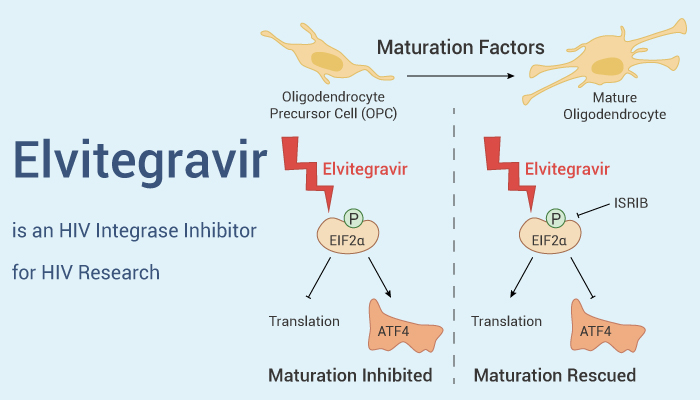Retrovirus is a virus that inserts a DNA copy of its RNA genome into the DNA of the host cell it invades, thereby changing the genome of that cell. After invading the host cell’s cytoplasm, the virus uses its own reverse transcriptase enzyme to produce DNA from its RNA genome. Many retroviruses cause serious disease in humans, other mammals, and birds. Retroviruses have many members, such as HIV. Elvitegravir (GS-9137; JTK-303; D06677) is an ideal inhibitor against a range of Retrovirus infections and is widely inhibits HIV integrase.
Elvitegravir inhibits HIV integrase and also affects cellular fatty acid synthesis and immunity.
In specifically, Elvitegravir is an HIV integrase inhibitor that is effective against HIV-1 and HIV-2. It inhibits the replication of HIV-1IIIB, HIV-2EHO and HIV-2ROD with IC50s of 0.7 nM, 2.8 nM and 1.4 nM, respectively. It blocks integration of HIV-1 cDNA by inhibiting DNA strand transfer. And it can inhibit the replication of murine leukemia virus and simian immunodeficiency virus. This’s indicating that integrase inhibitors bind to the conformationally conserved region of various retroviral integrase enzymes. RAG1 is a key enzyme involved in V(D)J recombination and is structurally similar to HIV integrase. Elvitegravir interferes with physiological functions of RAG, such as binding, cleavage, and hairpin formation at the recombination signal sequence (RSS).
Elvitegravir also inhibits the formation of coding and signaling junctions in pre-B cells, resulting in a significant reduction in mature B lymphocytes in 70% of the mice studied. Moreover Elvitegravir exhibits inhibitory effect on lipid synthesis in primary rat oligodendrocyte cultures. Elvitegravir (3.5-10 μM; 3 d) induces cell loss in a dose-dependent manner in oligodendrocyte precursor cells (OPCs). It significantly reduces cell viability by approximately 10% at 10 μM. It (6 μM; 3 d) impairs oligodendrocyte differentiation and inhibits fatty acid synthesis in MT-2 and MT-4 cells, but does not impair cholesterol synthesis.
Additionally, Elvitegravir is delivered subcutaneously into mice via drug-loaded nanoparticles (NPs). In female humanized CD34+-NSG mice, longer residence times and exposure times were produced. The elimination half-lives (t1/2) of Elvitegravir administered alone and NP-delivered were 10.8 hours and 3.3 days, respectively. This suggests that Elvitegravir provides sustained release with a long-acting mode of action.
In summary, Elvitegravir is a potent retroviral inhibitor that targets HIV and RAG enzymes and inhibits viral replication. At the same time, Elvitegravir also affects lipid synthesis in oligodendrocyte cultures and has an inhibitory effect on B lymphocytes.
References:
[1] Shimura K, et al. J Virol. 2008 Jan;82(2):764-74.
[2] Monnerie H, et al. Front Mol Neurosci. 2023 Dec 11;16:1323431.
[3] Nishana M, et al. Cell Death Dis. 2017 Jun 1;8(6):e2852.
